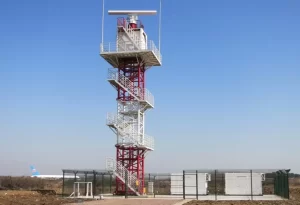Surface Movement Radar (SMR) is a type of radar system that is used primarily by air traffic controllers to monitor the movement of aircrafts on the ground, such as taxiing, takeoff, and landing. SMR technology utilizes radio waves to track aircraft movements, and can provide highly accurate data on aircraft positions, speeds, and headings.
SMR is a critical technology for air traffic control as it helps to ensure safe and efficient movement of aircraft on the ground, thereby minimizing the risk of collisions or other accidents. Without SMR, airports would rely primarily on visual observations by air traffic controllers, which can be limited in certain weather conditions or during periods of high traffic volume.

Upcoming Trends in SMR Technology
There are several upcoming trends in SMR technology that could significantly impact the operation of airports and the use of SMR technology. These include the integration of artificial intelligence (AI), the use of passive radar, and the deployment of highly automated systems.
AI integration could enable SMR systems to analyze data from multiple sources, such as weather radar and flight schedules, in real-time to make more accurate and informed decisions. For example, the system could automatically reroute flights around areas of heavy precipitation or turbulence, reducing delays and increasing safety.
Passive radar involves using existing radio signals such as TV and radio broadcasts, rather than actively transmitting energy like traditional radar systems. By using passive radar, airports can reduce their energy consumption, eliminate emissions, and reduce the potential for interference with other electronic systems. Passive radar can provide an additional layer of security, as it can detect not only aircraft movement but also other moving objects, such as ground vehicles or drones.
Highly automated SMR systems can help to improve the efficiency and safety of airport operations. For instance, it could automate the monitoring and control of aircraft traffic and reduce the need for manual intervention by air traffic controllers. This can help to reduce costs, increase productivity, and reduce the risk of human error.
Deployment of highly automated SMR technologies along with the integration of artificial intelligence and the use of passive radar technology could lead to the development of intelligent airports. Intelligent airports could provide enhanced security, improved operational efficiency, reduced carbon emissions, and an overall improved travel experience for passengers.
Examples of intelligent airport technologies deployed of SMR would be runway incursion protection, advanced routing of aircraft and ground vehicles, facade analysis capabilities, and decision support tools for air traffic controllers to aid in the resolution of incidents.
Developments in SMR Technology
Two significant developments in the SMR technology landscape are the shift toward digital radar processing and the increased use of radar networks.
Digital radar processing, also known as pulse compression radar, uses modern digital signal processing techniques to improve the detection and measurement of radar signals. This approach enhances the precision of radar data and improves the radar target localization, leading to higher data quality and more accurate tracking of objects. Digital radar processing improves SMR performance by providing more detailed information on weather and aircraft, which enhances the situational awareness of controllers and allows for more proactive decision-making.
The increased use of radar networks involves combining data from multiple radar systems, resulting in more extensive coverage and more complete information about the movements of aircraft and other objects. This network of radar systems provides redundancy, which means that in case of any failure of one radar, the other radars continue to function seamlessly.
This capability leads to more reliable radar coverage of an area. Even areas with complex terrain or with significant topographic changes can be covered efficiently through the deployment of multiple radars. This increased capability results in improved safety in airports and reduction in delays, as airports can accommodate more flights in a given airspace.
Moreover, the increased use of radar networks leads to the creation of a robust and scalable surveillance solution that can meet multiple surveillance requirements, such as airport surface surveillance, and terminal area surveillance. These networks enable controllers to track aircraft beyond the conventional air traffic control radar coverage, consequently offering uninterrupted coverage on the flight route.
In conclusion, the shift toward digital radar processing and the increased use of radar networks in the SMR technology landscape are promising developments that enhance SMR performance, provides reliable data, improves situational awareness, and provides redundancy. These advancements will improve safety and help mitigate challenges with congestion resulting from the increased number of flights.
Conclusion
Surface Movement Radar (SMR) technology is an essential tool for air traffic control, enabling operators to track and manage the movement of aircraft on runways, taxiways, and aprons. As air traffic continues to grow globally, the future of SMR technology looks very promising. However, there are still some potential challenges that SMR technology may face in the future.
Despite these challenges, SMR technology has a bright future ahead. The aviation industry should encourage its growth by investing in research and development, providing incentives to manufacturers and operators who transition to SMR technology, and integrating it with other advanced air traffic control systems such as Automatic Dependent Surveillance - Broadcast (ADS-B).
In conclusion, SMR technology is an essential part of air traffic control, and its future looks promising. To succeed in the years to come, SMR manufacturers and operators must continually innovate and embrace new technologies while working with the aviation industry to encourage its growth.
To learn more about SMR and other aviation technologies, visit our website at mskyeye.com.

